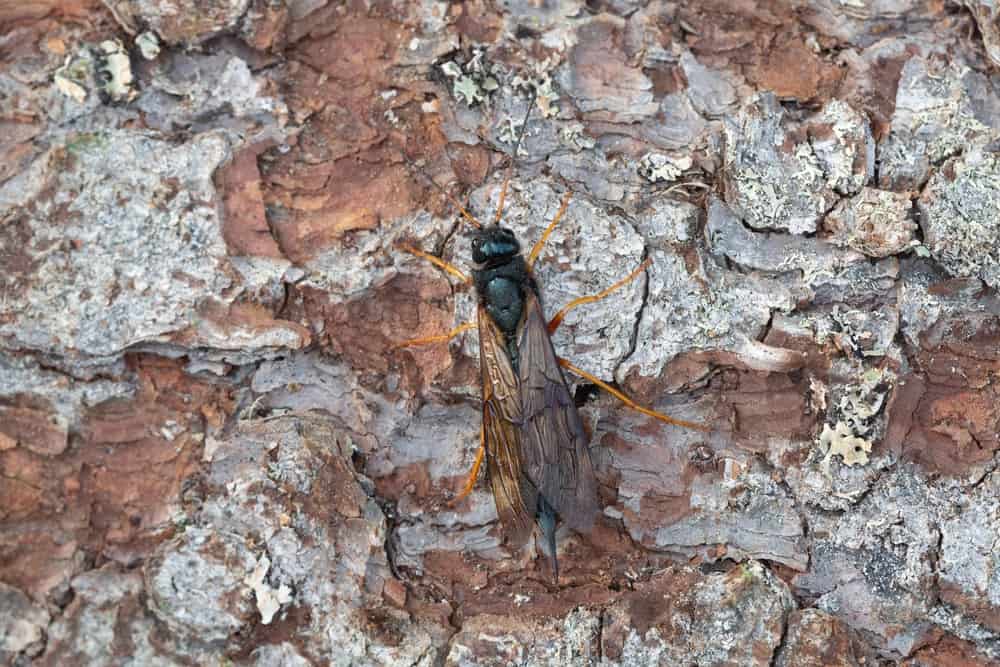When people see damaged wood in the walls of their homes, their instinct is to panic. The first thought that might pop into your head could be termites or bees. But if you’re lucky, the infestation in your home might not be either of these. Maybe it’s something a lot less harmful, like wasps.
Today, we will talk about the wasp that eats wood: the horntail wasp. This type of wasp—also known as a wood wasp—is non-social and stays in dead wood only. But while it’s low-risk for people, it can still wreak havoc on your wooden walls and floor at home or even your trees in the garden.
Horntail wasps are relatively huge and might look like hornets and stingers. But really, you have nothing to be afraid of unless you’re a tree. Let’s take a closer look at this misunderstood insect and see why they aren’t as scary as they seem (and how much they love wood!).
What are Horntail Wasps?
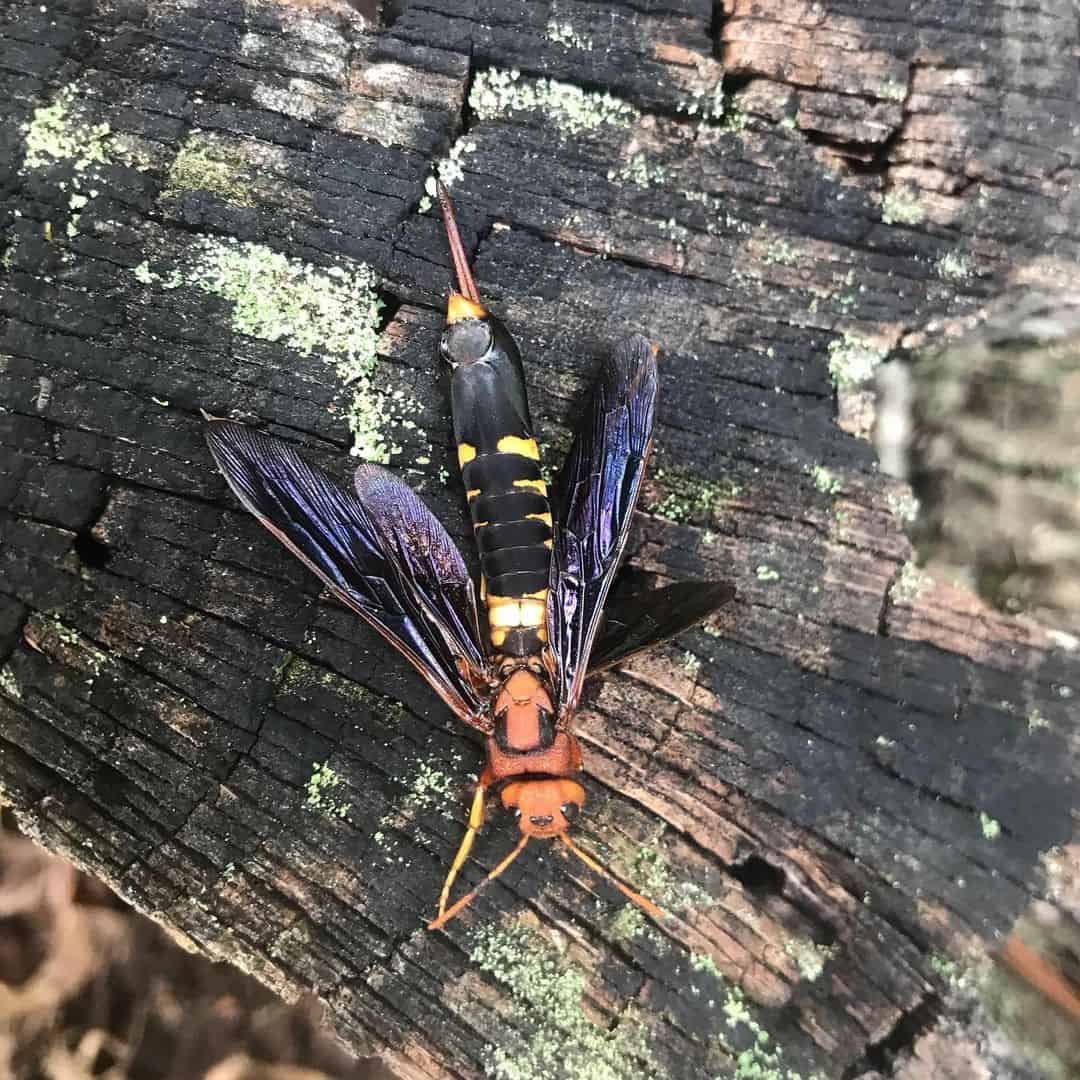
Image Credit: liv2hik2
Horntail wasps are relatively large, wood-boring insects from the family Siricidae. These wasps are known for completing their entire life cycle in dead wood or dying, stressed-out trees. Because lumber is made of wood, these wasps can sometimes be found in homes and buildings as well.
These non-social wasps—also called wood wasps because of their favorite place to live—are quite large. They are at least an inch long and have a cylindrical body. They are mostly dark blue or black with a mixture of yellow or red markings on their bodies.
The reason why they’re called “horntail” wasps is because they have a protruding abdomen that looks like a stinger.
There are plenty of different horntail wasp species in the world, many of which come from the eastern United States. Coastal states like California, Washington, and Oregon are known to have many of these wasps flying around, looking for their next batch of tree trunks to live in.
If you want to see what a horntail wasp looks like, check out this clip of a giant wood wasp:
Horntail Wasps are Notorious for Living in and Eating Wood
The most distinctive characteristic of horntail wasps is that they are wood borers. As young larvae, they are burrowed into trees and other forms of dying wood, and they live there for the rest of their lives. Not only do they nest and live in wood, but they also eat the wood that hosts them, too.
Wondering how they find their way into trees in the first place? Here’s how it goes down.
First, a female wood wasp will look for a suitable tree to lay her eggs in. Using her antennae, she will scout her options and survey the area for the best tree for her babies to call home.
This could be any dead tree, from maple, elm, and hickory trees to pines and oaks. She might even select tree stumps for the job.
When she finds the perfect place to lay eggs, she will drill a hole into the wood with her ovipositor. She creates a little “tunnel” that is just shy of an inch long inside the weakened wood and lays a few eggs in it. She also leaves behind some fungus that they can eat.
Watch as this female horntail wasp looks for the best spot in her tree of choice when she’s about to lay her eggs:
When the eggs hatch, the larvae will come out. They will find themselves deep in the wood, where they will feast on the heartwood or sapwood of the tree in their immature stages of life. This is where the wood wasp larvae will live until they become full-fledged adult wasps.
After about two or three years, these adult wasps will start to eat more of the wood in their home to create exit holes. These holes will be tiny—about a quarter of an inch wide. From here, they’ll fly out and see the world for the first time.
Once they’re out, they won’t reinfest the wood they live in. However, when homeowners see them flying about, they may worry that their house’s infestation will become worse.
Fortunately, that is a misconception. These creatures are known to stay away from cut lumber and finished structures. The only reason they could end up inside a building is if the lumber used to build the structure already had an infestation to begin with.
How to Identify Wood Wasps
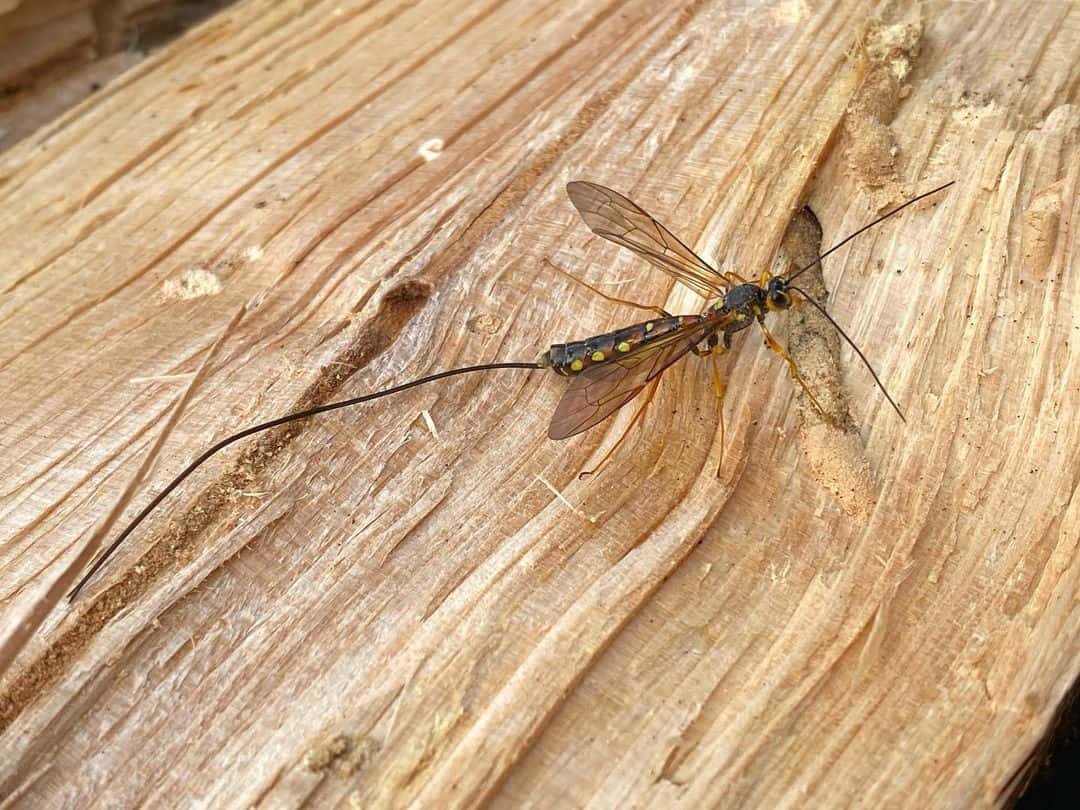
Image Credit: staycuriouskaryn
1. Horntail wasp sightings
The most common way to learn that a tree or wooden area in your home is infested with horntail wasps is by seeing the wasp with your own two eyes. If you see a horntail wasp that fits our description above, you may need to check on your trees and hardwoods.
2. Damaged wood in the home
The second sign that you have horntail wasps in your home is damaged wood. On both walls and dead, deciduous trees, the damage will look like the wood has crumbling sawdust or “frass.”
3. Exit holes in trees and wood walls
Adult wasps chew on the wood they live in to create exit holes they can fly out of when they’re all grown up. Seeing about 10-50 of these perfectly round holes in the wood they used to live in is not uncommon.
Watch out for these exit holes even after all the wasps have gotten out. If a female wood wasp wants to lay her eggs somewhere again, these holes are usually good candidates for her larvae’s habitat.
4. A persistent buzzing sound
Horntail wasps are known to be noisy and make a clicking or buzzing noise, like bees. You might hear a faint buzzing when you’re near their nest, whether it’s in the garden or one of the rooms in your home.
5. Birds hang out in your moldings more than usual
Scientists have found that birds can hear worms and larvae, even if we humans don’t think they make a sound. If you notice that more birds are hanging out in your trees and moldings at home than usual, it could be a sign that there are larvae in your wood.
Are Horntail Wasps Harmful to Humans?
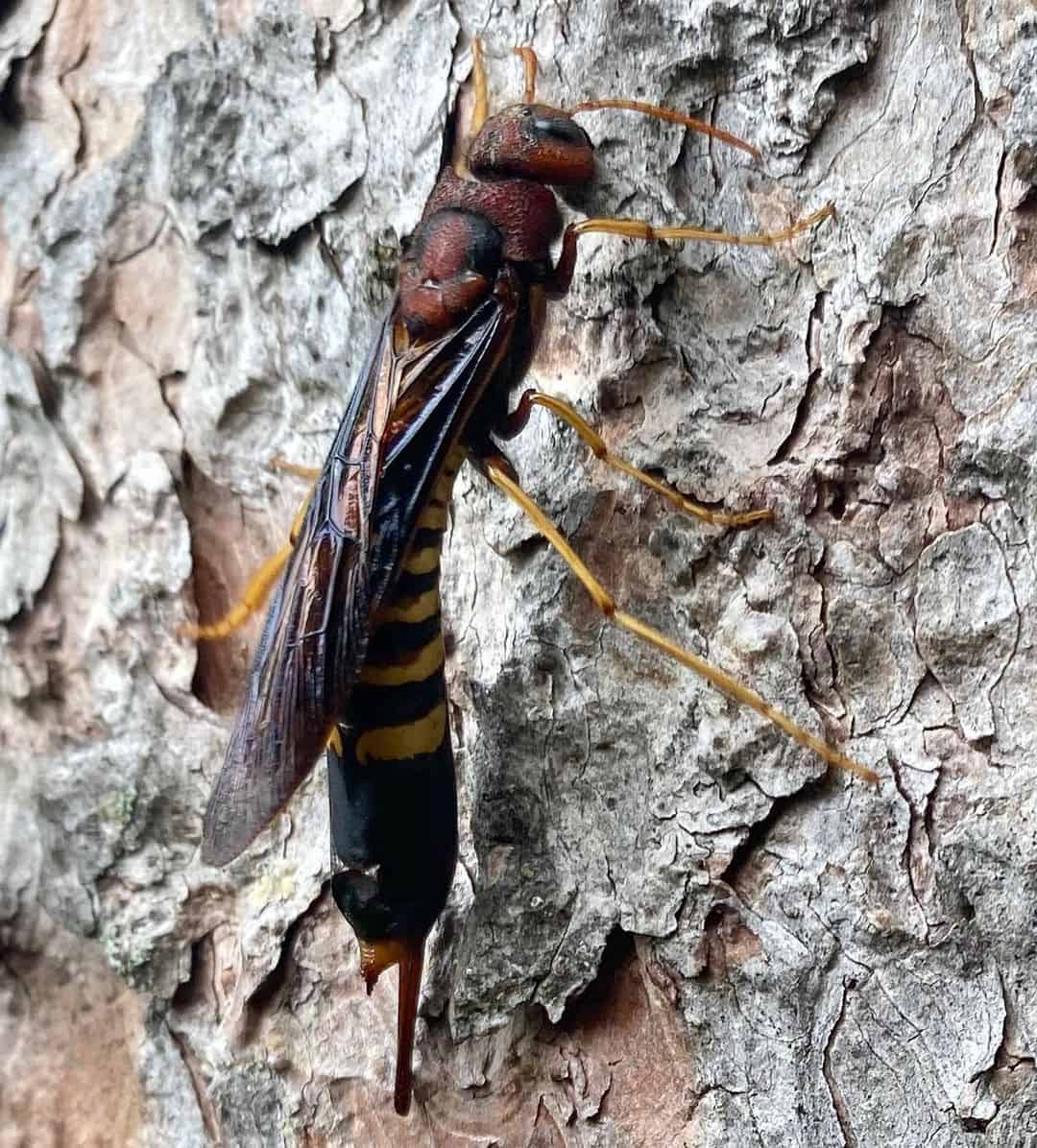
Image Credit: bartoleum
Horntail wasps can look quite frightening. They’re large, make a loud buzzing sound, and have a horn-like stomach that looks like it can sting and poison you. They can easily be confused with hornets and other stringers, like bees.
Fortunately, wood wasps don’t bite or sting people. They don’t even care to come near humans, as they are only attracted to wood. They don’t have venom either.
So, instead of stressing out and overthinking whether these wasps can harm you, it’s best to focus your efforts on saving your home and trees.
How to Prevent Horntail Wasps Infestations at Home
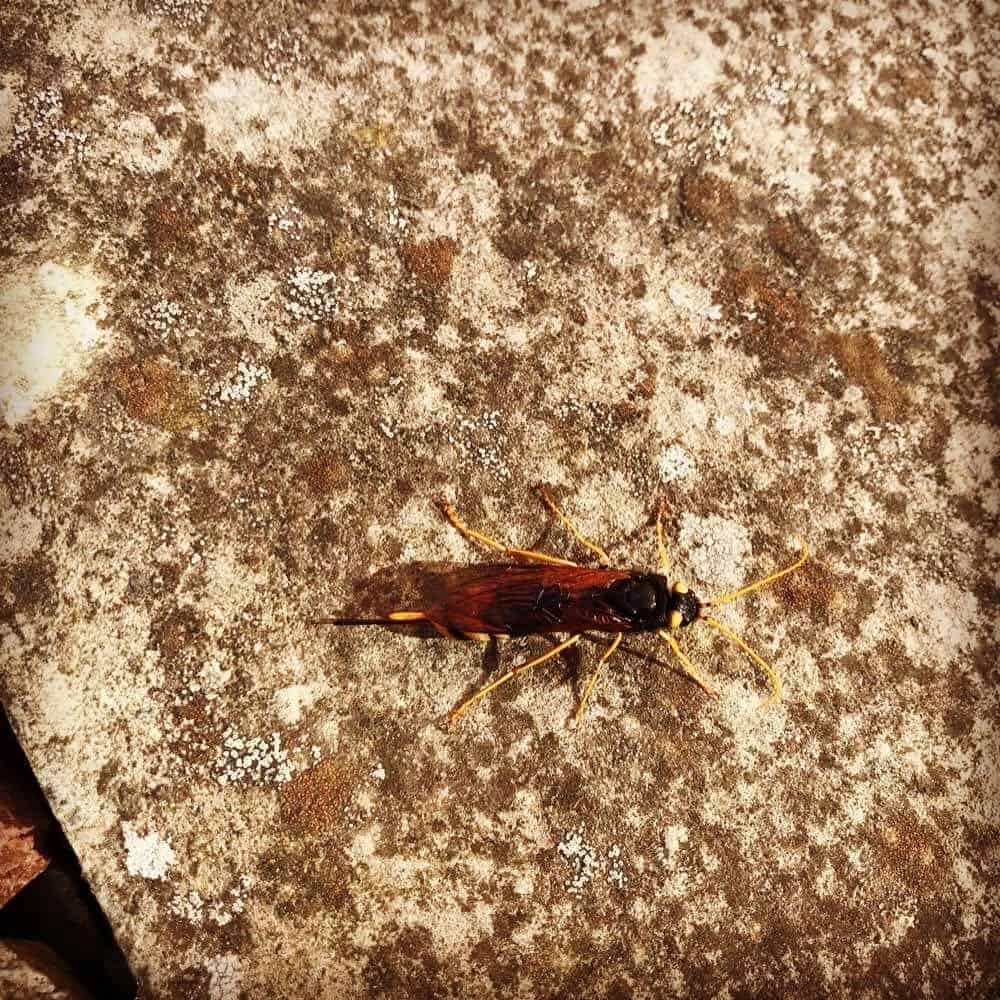
Image Credit: rentokilinitialuk
It’s likely that only a few horntail wasps will fly out of the trees and dead wood they’ve lived in for years. Because of this, it might be better and more practical to simply wait out their life cycle and let them fly away when they’re adults. After all, they don’t go back into their homes anyway.
But if you want to prevent future horntail wasp infestations in your home, here’s what we recommend you should do.
1. Store firewood outside your house only
Horntail wasps love dead or dying wood. So, always keep your supply of firewood outdoors, never indoors. If you need to use firewood inside the house, only bring them in right as you’re about to use them.
2. Use a horntail repellant to protect healthy trees
If one of the trees in your garden has horntail wasps living in it, it’s highly possible that the trees around it are candidates for female wasps to lay their next batch of eggs in when the wood is dying.
To save your trees, consider spraying your healthy trees with horntail wasp repellant to keep female wasps at bay.
3. Call pest control when you need backup
Lastly, never be afraid to call pest control if you don’t know what to do. If the buzzing sound is too loud or if you notice another area that is infested, it’s super valid to call the professionals to handle it.
Sure, horntail wasps are technically harmless to humans, but do what you have to do to save your trees and wooden furniture, walls, and flooring.
Conclusion
Horntail wasps may look like bees and hornets, but for the most part, they are quite harmless to humans. Instead of sucking on people’s skin, they only hang around trees and dead wood.
That said, you still have to watch out for them if you have a home with areas made of lumber and some trees in your garden. These are spots where you might discover these wasps as they fly out of the holes they create in the wood.
Because they’re harmless, most people wait out the wasps’ life cycle instead of getting pest control. But if you want to keep wood wasps out, store firewood outside, use repellant on your healthy trees, and put pest control on speed dial if you suspect an infestation.
